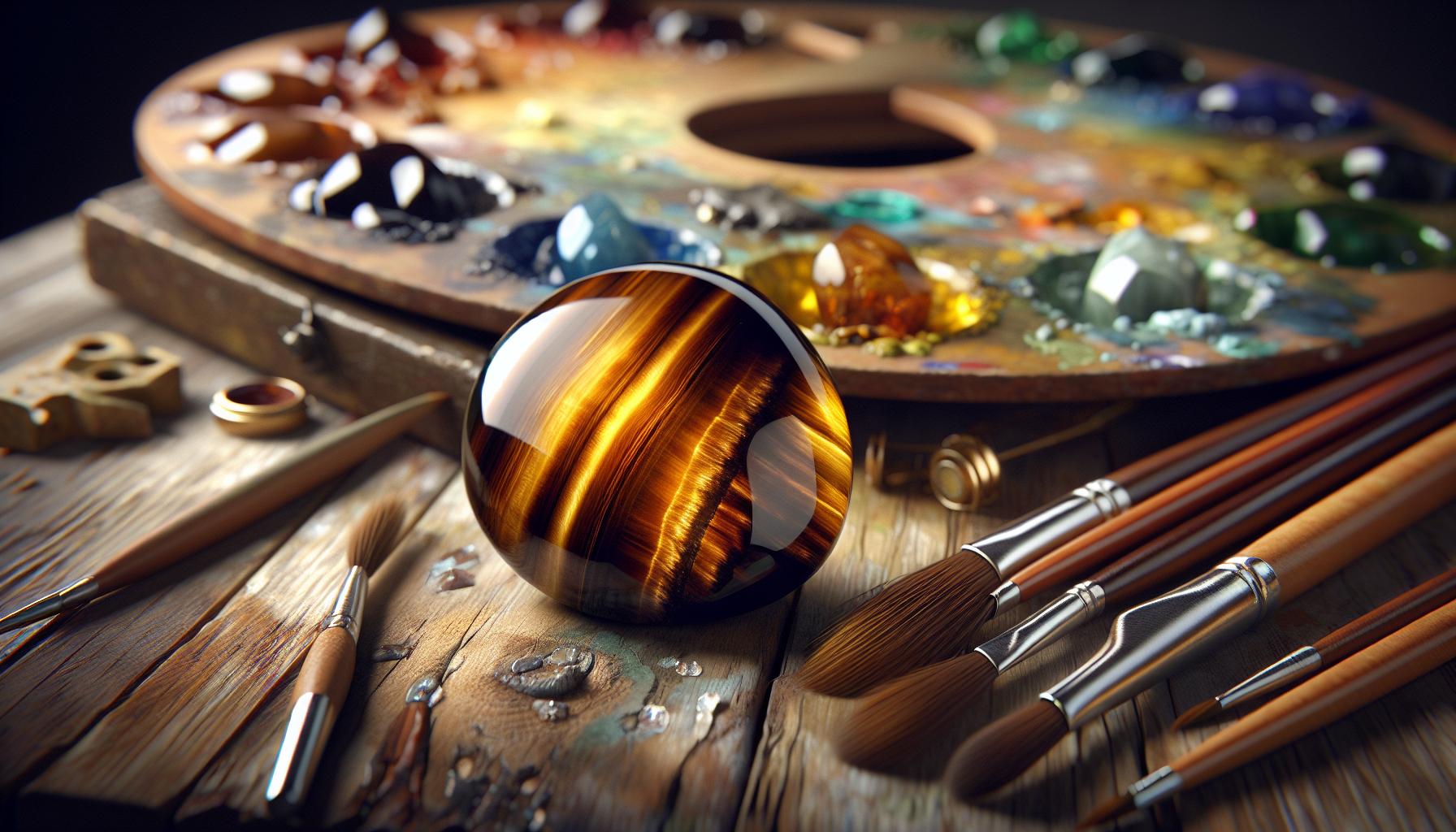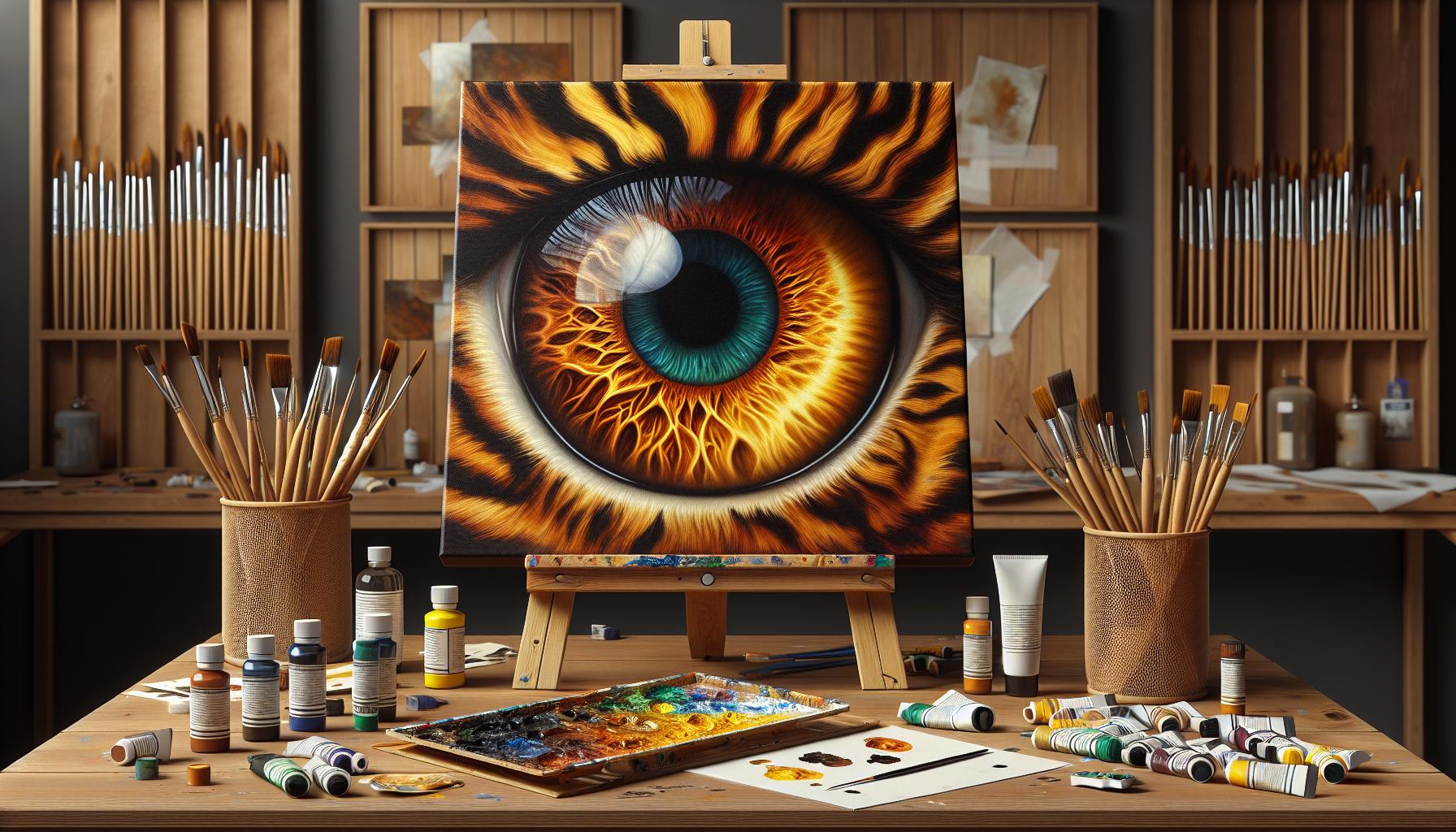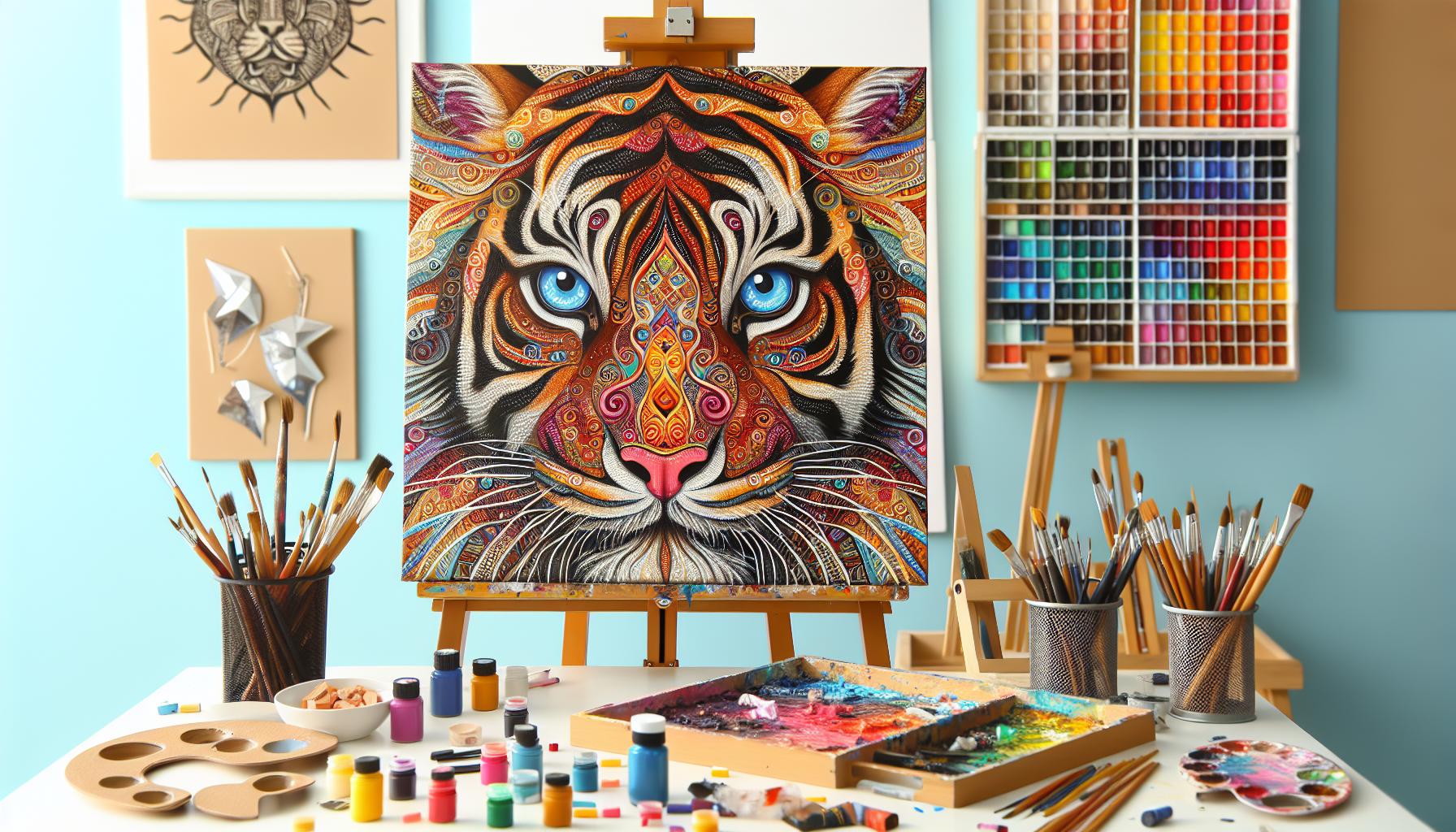Tiger eye painting captivates with its mesmerizing depth and rich colors, drawing me into a world where art meets nature’s beauty. This unique technique, inspired by the striking patterns of the tiger eye gemstone, allows artists to create stunning visual effects that resemble the shimmering surface of the stone itself.
As I explore the intricacies of tiger eye painting, I discover how this art form blends traditional methods with modern creativity. It’s not just about the finished piece; it’s about the journey of transforming simple materials into something extraordinary. Whether you’re an aspiring artist or simply appreciate the beauty of art, understanding tiger eye painting opens up a new realm of inspiration and expression.
Table of Contents
ToggleKey Takeaways
- Inspiration from Nature: Tiger eye painting draws heavily from the stunning patterns and colors of the tiger eye gemstone, allowing artists to create artworks that reflect nature’s beauty.
- Techniques and Materials: Artists utilize various techniques, including layering and glazing, with materials like acrylics and oils to replicate the shimmering texture of tiger eye stones.
- Accessibility for All Skill Levels: This art form is suitable for beginners and experienced painters alike, offering simplified techniques for novices while providing advanced methods for seasoned artists.
- Emotional Exploration: Engaging with tiger eye painting promotes themes of strength and transformation, allowing artists to connect emotionally with their work and invite viewers into a deeper experience.
- Cultural Significance: The history of tiger eye painting encompasses cultural narratives that highlight the gemstone’s symbolism and its evolution through different artistic eras.
- Benefits Beyond Art: Creating tiger eye paintings offers numerous benefits, including skill development, stress relief, cultural appreciation, and a sense of community through shared artistic experiences.
Overview of Tiger Eye Painting
Tiger eye painting draws inspiration from the striking patterns found in tiger eye gemstones. This art form showcases vibrant colors, including rich golds, browns, and deep blacks, creating a captivating visual experience. Artists often incorporate various techniques, such as layering and blending, to mimic the gemstone’s natural look and texture.
The process of creating tiger eye paintings involves using high-quality paints and brushes to achieve intricate details. Many artists prefer acrylics for their versatility and quick-drying properties. Others may opt for oil paints to capture stunning depth and luminosity. Regardless of the medium, the goal remains to reflect the gemstone’s captivating shimmer and flow.
Accessibility is a key feature of this art style, appealing to artists at all skill levels. Beginners can start with simplified techniques, while experienced painters can explore advanced approaches to enhance their portfolio. Tiger eye painting serves both as an expression of creativity and as an opportunity to develop fine motor skills and artistic flair.
Tiger eye painting promotes emotional exploration by allowing artists to connect with the themes of strength and transformation associated with the tiger eye gemstone. This connection enhances the paintings’ impact, inviting viewers to engage with the art on a deeper level. Engaging in this art form fosters an appreciation for the natural world and its aesthetic beauty.
History of Tiger Eye Painting

Tiger eye painting blends traditional artistry with contemporary techniques, rooted in cultural narratives and artistic evolution.
Origin and Cultural Significance
Tiger eye painting traces its origins to various cultures that revered the tiger eye gemstone for its protective properties and vibrant patterns. Ancient civilizations, including the Egyptians and Romans, valued the stone not just for jewelry but also for its symbolic meanings, representing courage and strength. The art form emerged as a way to capture the gemstone’s beauty, allowing artists to convey themes of resilience and transformation through their work.
Evolution Through Eras
Tiger eye painting reflected the artistic movements of different eras, adapting techniques and styles. In the early phases, artisans utilized natural pigments mixed with binders to create textures reminiscent of the gemstone’s surface. During the Renaissance, the focus shifted toward realism, with artists emphasizing effective light and shadow to replicate the gemstone’s depth. The modern era introduced acrylics and oils, enabling more vibrant expressions and techniques, making the art form accessible to a wider range of artists. As a result, tiger eye painting has evolved into a versatile medium that celebrates the interplay between tradition and innovation.
Techniques Used in Tiger Eye Painting

Tiger eye painting combines traditional techniques with modern tools, allowing for an array of artistic expressions. I often find that understanding the fundamental materials and the step-by-step process enhances my ability to create captivating pieces.
Materials and Tools
I rely on high-quality paints to capture the rich colors and intricate patterns of tiger eye stones. Popular choices include:
- Acrylic Paints: Quick-drying, vibrant, and versatile, perfect for layering.
- Oil Paints: Slow-drying, allowing for blending and depth, ideal for detailed work.
- Paintbrushes: A variety of sizes, from fine-tipped for intricate details to broader brushes for larger coverage.
- Canvas or Wood Panels: Sturdy surfaces that provide a solid foundation for my artwork.
- Palette Knives: Useful for mixing colors and creating texture.
- Varnish: Applied after completion for a glossy finish that enhances the shimmer.
Using the right materials elevates the artwork’s quality and allows for experimentation.
- Preparation: I start by selecting a clean canvas or wood panel, ensuring it’s primed and ready for painting.
- Sketching: I lightly sketch the design, outlining the tiger eye patterns to guide my painting process.
- Base Layer: I apply a base coat with diluted acrylic or oil paint, establishing the primary colors and background.
- Building Layers: I build layers, painting from darker to lighter tones. I use glazing techniques to achieve transparency and depth.
- Detailing: I focus on details using fine brushes to create texture and mimic the gemstone’s shimmer. Highlighting and shading enhance realism.
- Final Touches: I assess the painting, adding any final touches, such as highlights with a small brush or palette knife.
- Sealing: I allow the artwork to dry completely before applying a varnish, protecting the painting and enhancing its vibrancy.
Mastering these techniques in tiger eye painting not only improves my skills but also deepens the connection to the artwork, allowing me to express themes of strength and transformation.
Artistic Styles in Tiger Eye Painting

Tiger eye painting showcases a diverse array of artistic styles, reflecting traditional approaches and contemporary innovations that enrich its visual language.
Traditional Approaches
Traditional approaches in tiger eye painting emphasize the cultural significance of the gemstone. Many artists draw inspiration from ancient techniques, incorporating natural pigments and time-honored methods. Techniques such as layering and glazing create depth that mimics the gemstone’s unique patterns. Artists may also utilize symbolism, embedding themes of courage and protection that tie back to historical reverence for the stone. Mastery of these traditional methods leads to authentic works that honor the origins of tiger eye art.
Contemporary Innovations
Contemporary innovations in tiger eye painting highlight the fusion of modern materials and creative freedom. Artists often experiment with mixed media, blending digital tools with traditional paint techniques. Such innovations include using resin to enhance color vibrancy and texture, making artworks more dynamic. Artists also explore abstract styles, moving beyond realism to evoke emotion through color and form. These modern practices invite a broader audience, connecting tiger eye painting to current artistic trends while retaining its distinct heritage.
Benefits of Tiger Eye Painting
Tiger eye painting offers various benefits that resonate with both artists and art enthusiasts.
- Emotional Connection: Engaging in this art form fosters a deep emotional connection, allowing me to explore themes of strength and transformation. The soothing colors and intricate patterns provide a sense of calm and empowerment.
- Skill Development: Practicing tiger eye painting enhances my artistic skills. Each step, from sketching to layering, builds my confidence and proficiency with various techniques, which translates to improved overall artistry.
- Stress Relief: This creative process serves as a form of stress relief. Immersing myself in the vibrant colors and mesmerizing patterns allows me to escape daily pressures, promoting relaxation and mindfulness.
- Cultural Appreciation: Delving into tiger eye painting enriches my understanding of its cultural significance. Learning about the gemstone’s historical importance across civilizations deepens my appreciation for the art form and its heritage.
- Community Engagement: Joining workshops or online communities focused on tiger eye painting connects me with fellow artists. Sharing experiences and techniques fosters camaraderie, allowing me to learn and grow within a supportive network.
- Versatility: The techniques and materials used in tiger eye painting are versatile, enabling creativity in multiple styles. Whether I choose traditional or contemporary methods, each approach offers unique opportunities for self-expression.
- Artistic Fulfillment: Completing a tiger eye painting provides immense fulfillment. Observing the final piece, reflecting the intricate beauty of the gemstone, instills a sense of accomplishment and pride in my artistic journey.
Tiger eye painting is more than just an art form; it’s a journey of self-discovery and creativity. I’ve found that the vibrant colors and intricate patterns not only captivate the eye but also evoke a deep emotional connection. Whether I’m a beginner or an experienced artist, this technique offers endless possibilities for expression.
Exploring the rich history and cultural significance of tiger eye has enriched my appreciation for this art. It’s a beautiful blend of tradition and modernity that invites everyone to participate. I encourage you to dive into this mesmerizing world and experience the transformative power of tiger eye painting for yourself.



